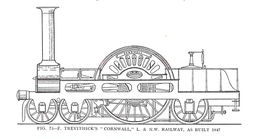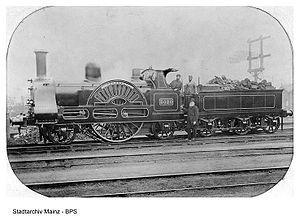- LNWR Cornwall
-
Cornwall  La Cornwall telle que construite en 1847.
La Cornwall telle que construite en 1847.Identification Désignation : LNWR 3020 Concepteur : F. Trevithick Construction : 1847 Transformation : J. Ramsbottom
1858Retrait : 1902 Nombre : 1 (préservée) Caractéristiques techniques 1847 / 1858 Disposition des essieux : ooOo + T
oOo + TCylindres :
Alésage * course :2 externes
445 * 610
438 * 610
mmDiamètre des roues AV :
Diamètre roues motrices :
Diamètre des roues AR :1067
2591
1219mm
mm
mmEmpattement : 5.029
4.021m Vitesse maximale : 80 (110) km/h La Cornwall (« Cornouailles ») est une locomotive à vapeur d'architecture innovante, conçue pour le London and North Western Railway par Francis Trevithick, fils de Richard Trevithick. Construite en 1847, elle est du type 211 avec des roues motrices de très grande taille. Elle a été présentée à l'Exposition universelle de 1851.
La solution privilégiée à l'époque pour réaliser des locomotives rapides, reposait sur des roues motrices de grand diamètre. Mais la hauteur de l'axe de ces roues était incompatible de la recherche — jugée pertinente à l'époque — d'un centre de gravité suffisamment bas pour que les locomotives restent stables en virage. Les locomotives Crampton optaient pour une chaudière assez basse et un essieu moteur placé derrière la chaudière. Cette locomotive explorait une option plus radicale, en augmentant encore la taille de l'essieu moteur (avec un diamètre de 2.59 m) et en plaçant la chaudière… ni plus ni moins que sous l'essieu. Une troisième architecture sera explorée en 1855 avec l'Aigle et sa chaudière à deux corps. Mais ces deux tentatives s'avérèrent infructueuses, principalement du fait de la taille limitée de la chaudière. On s'est depuis convaincu qu'un CdG bas n'est pas déterminant pour la stabilité de la locomotive et que le relever permet de mieux solliciter la voie, en soulageant les efforts transverses au profit d'efforts verticaux.
C'est pour cela que ce prototype a été profondément reconstruit en 1858, devenant une 111 classique, avec la chaudière placée au-dessus de l'essieu moteur malgré sa hauteur.
Elle est conservée au Shildon Locomotion Museum.
Catégories :- Histoire des chemins de fer
- Locomotive à vapeur primitive
- Véhicule historique
Wikimedia Foundation. 2010.

